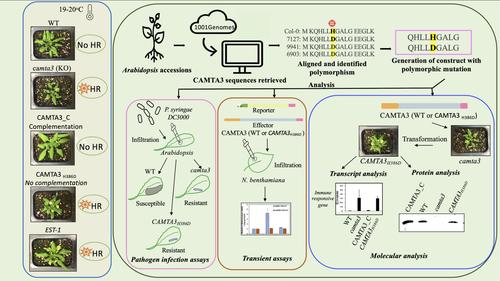当前位置:
X-MOL 学术
›
Mol. Plant Pathol.
›
论文详情
Our official English website, www.x-mol.net, welcomes your feedback! (Note: you will need to create a separate account there.)
A natural single-nucleotide polymorphism in the CAMTA3 transcription factor regulates its function and transcription of its target genes
Molecular Plant Pathology ( IF 4.9 ) Pub Date : 2024-02-07 , DOI: 10.1111/mpp.13428 Kasavajhala V. S. K. Prasad 1 , Amira A. E. Abdel‐Hameed 1 , Anireddy S. N. Reddy 1
Molecular Plant Pathology ( IF 4.9 ) Pub Date : 2024-02-07 , DOI: 10.1111/mpp.13428 Kasavajhala V. S. K. Prasad 1 , Amira A. E. Abdel‐Hameed 1 , Anireddy S. N. Reddy 1
Affiliation

|
CAMTA3, a Ca2+/calmodulin-binding transcription factor, is a key regulator of plant immunity in Arabidopsis. Here, we identified a novel naturally occurring single-nucleotide polymorphism that results in a missense nonconservative mutation (CAMTA3H386D) in many Arabidopsis ecotypes. This region of CAMTA3 is not part of any previously characterized regulatory domains. To study the consequence of this change on the function of CAMTA3, we introduced the CAMTA3H386D into camta3, a loss-of-function mutant that exhibits a constitutive cell death phenotype, chlorotic lesions on leaves, and reduced plant size. Phenotypic and molecular analysis of these lines indicated that the expression of CAMTA3H386D in the camta3 mutant did not complement the mutant phenotypes. Also, the ecotypes containing the CAMTA3H386D exhibited camta3 phenotypes. Marker genes associated with salicylic acid biosynthesis and pathogen response were upregulated in the CAMTA3H386D lines and the Arabidopsis accessions 7127 (Est-1) and 9941 (Fei-0), as in camta3, indicating that H386D mutation alters CAMTA3 activity in regulating the expression of known target genes. In Nicotiana benthamiana transient expression assays, CAMTA3H386D failed to induce the expression of a luciferase reporter gene driven by the rapid stress-responsive elements (RSRE) that contain the known binding sites of CAMTA3, suggesting that CAMTA3H386D mutation impairs its ability to activate its target genes. Transgenic lines and tested natural accessions expressing CAMTA3H386D showed enhanced levels of H2O2 and increased resistance to the bacterial pathogen Pseudomonas syringae pv. tomato DC3000. Collectively, our results indicate that the H386D mutation in a previously unknown regulatory region of CAMTA3 is essential for its function.
中文翻译:

CAMTA3 转录因子中的天然单核苷酸多态性调节其功能和靶基因的转录
CAMTA3 是一种Ca 2+ /钙调蛋白结合转录因子,是拟南芥植物免疫的关键调节因子。在这里,我们鉴定了一种新的自然发生的单核苷酸多态性,该多态性导致许多拟南芥生态型中出现错义非保守突变( CAMTA3 H386D)。 CAMTA3 的该区域不属于任何先前表征的调控域。为了研究这种变化对 CAMTA3 功能的影响,我们将CAMTA3 H386D引入camta3中,这是一种功能丧失的突变体,表现出组成性细胞死亡表型、叶片褪绿病变和植株尺寸减小。这些品系的表型和分子分析表明, camta3突变体中CAMTA3 H386D的表达不与突变体表型互补。此外,含有CAMTA3 H386D的生态型表现出camta3表型。与水杨酸生物合成和病原体反应相关的标记基因在CAMTA3 H386D系和拟南芥种质 7127 (Est-1) 和 9941 (Fei-0) 中上调,如camta3中一样,表明 H386D 突变改变了 CAMTA3 在调节表达方面的活性已知的靶基因。在本塞姆氏烟草瞬时表达测定中,CAMTA3 H386D未能诱导由包含 CAMTA3 已知结合位点的快速应激反应元件 (RSRE) 驱动的荧光素酶报告基因的表达,表明 CAMTA3 H386D突变削弱了其激活荧光素酶报告基因的能力。目标基因。表达 CAMTA3 H386D 的转基因品系和测试的天然种质显示 H 2 O 2水平增强,并且对细菌病原体丁香假单胞菌pv. 的抗性增强。番茄DC3000。总的来说,我们的结果表明 CAMTA3 先前未知的调控区域中的 H386D 突变对其功能至关重要。
更新日期:2024-02-07
中文翻译:

CAMTA3 转录因子中的天然单核苷酸多态性调节其功能和靶基因的转录
CAMTA3 是一种Ca 2+ /钙调蛋白结合转录因子,是拟南芥植物免疫的关键调节因子。在这里,我们鉴定了一种新的自然发生的单核苷酸多态性,该多态性导致许多拟南芥生态型中出现错义非保守突变( CAMTA3 H386D)。 CAMTA3 的该区域不属于任何先前表征的调控域。为了研究这种变化对 CAMTA3 功能的影响,我们将CAMTA3 H386D引入camta3中,这是一种功能丧失的突变体,表现出组成性细胞死亡表型、叶片褪绿病变和植株尺寸减小。这些品系的表型和分子分析表明, camta3突变体中CAMTA3 H386D的表达不与突变体表型互补。此外,含有CAMTA3 H386D的生态型表现出camta3表型。与水杨酸生物合成和病原体反应相关的标记基因在CAMTA3 H386D系和拟南芥种质 7127 (Est-1) 和 9941 (Fei-0) 中上调,如camta3中一样,表明 H386D 突变改变了 CAMTA3 在调节表达方面的活性已知的靶基因。在本塞姆氏烟草瞬时表达测定中,CAMTA3 H386D未能诱导由包含 CAMTA3 已知结合位点的快速应激反应元件 (RSRE) 驱动的荧光素酶报告基因的表达,表明 CAMTA3 H386D突变削弱了其激活荧光素酶报告基因的能力。目标基因。表达 CAMTA3 H386D 的转基因品系和测试的天然种质显示 H 2 O 2水平增强,并且对细菌病原体丁香假单胞菌pv. 的抗性增强。番茄DC3000。总的来说,我们的结果表明 CAMTA3 先前未知的调控区域中的 H386D 突变对其功能至关重要。



























 京公网安备 11010802027423号
京公网安备 11010802027423号